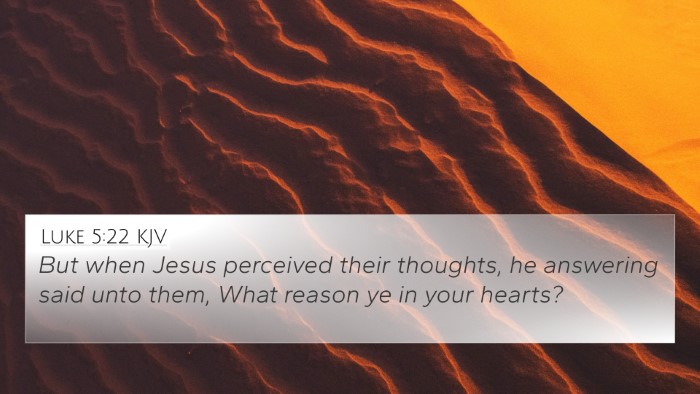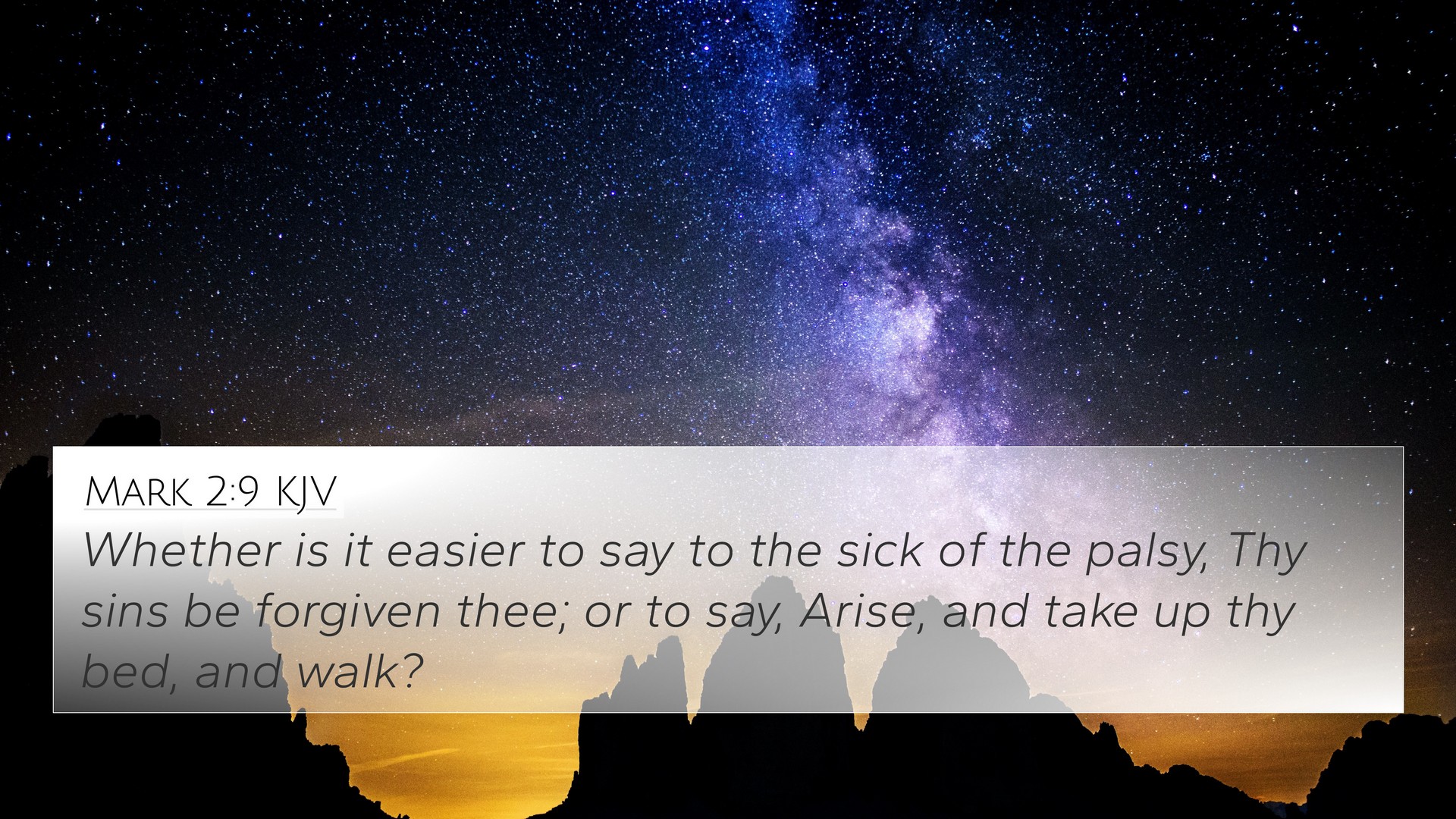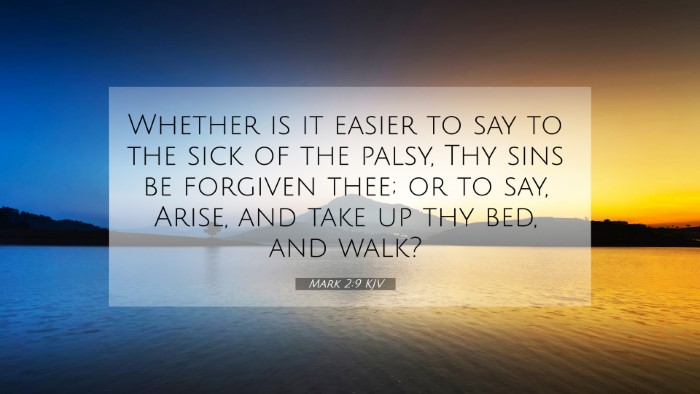Old Testament
Genesis Exodus Leviticus Numbers Deuteronomy Joshua Judges Ruth 1 Samuel 2 Samuel 1 Kings 2 Kings 1 Chronicles 2 Chronicles Ezra Nehemiah Esther Job Psalms Proverbs Ecclesiastes Song of Solomon Isaiah Jeremiah Lamentations Ezekiel Daniel Hosea Joel Amos Obadiah Jonah Micah Nahum Habakkuk Zephaniah Haggai Zechariah MalachiMark 2:9 Similar Verses
Mark 2:9 Cross References
Whether is it easier to say to the sick of the palsy, Thy sins be forgiven thee; or to say, Arise, and take up thy bed, and walk?
Uncover the Rich Themes and Topics of This Bible Verse
Listed below are the Bible themes associated with Mark 2:9. We invite you to explore each theme to gain deeper insights into the Scriptures.
Mark 2:9 Cross Reference Verses
This section features a detailed cross-reference designed to enrich your understanding of the Scriptures. Below, you will find carefully selected verses that echo the themes and teachings related to Mark 2:9 KJV. Click on any image to explore detailed analyses of related Bible verses and uncover deeper theological insights.

Luke 5:22 (KJV) »
But when Jesus perceived their thoughts, he answering said unto them, What reason ye in your hearts?

Matthew 9:5 (KJV) »
For whether is easier, to say, Thy sins be forgiven thee; or to say, Arise, and walk?
Mark 2:9 Verse Analysis and Similar Verses
Understanding Mark 2:9
In Mark 2:9, Jesus poses the question, "Which is easier, to say to the paralytic, ‘Your sins are forgiven,’ or to say, ‘Rise, take up your bed and walk’?" This verse captures a critical moment in Jesus' ministry, highlighting the relationship between physical healing and spiritual forgiveness.
Contextual Analysis
This passage takes place when Jesus is confronted by scribes after healing a paralytic man. The challenge lies not only in the authority of Jesus to forgive sins but also in demonstrating His power through miraculous acts.
Commentary Insights
- Matthew Henry: Henry emphasizes the significance of Jesus' authority. He notes that forgiving sins is a profound act that requires divine authority, which Jesus, being God, inherently possesses. This implies that Jesus' words not only establish forgiveness but also emphasize the divine nature of His mission.
- Albert Barnes: Barnes focuses on the implications of Jesus’ rhetorical question, illustrating that while both pronouncements may seem conceptually equal, the visible miracle of healing carries substantial significance. He argues that Christ's ability to heal physically verifies His power to forgive spiritually.
- Adam Clarke: Clarke elaborates on the theological implications of the verse, interpreting it as a direct connection between faith, sin, and physical wellness. He stresses that to prioritize spiritual healing over physical needs is a crucial understanding of Jesus’ ministry.
Cross-Referencing Biblical Texts
To further understand Mark 2:9, we can identify several connections with other Bible verses that elucidate its themes:
- Isaiah 53:5: "But He was wounded for our transgressions, He was bruised for our iniquities..." - This Old Testament prophecy foreshadows Christ's mission of healing and forgiveness.
- Matthew 9:6: "But that you may know that the Son of Man has power on earth to forgive sins..." - This verse parallels Mark 2:9 and reiterates the authority of Jesus in forgiving sins.
- Luke 5:23: "Which is easier, to say, 'Your sins are forgiven you,' or to say, 'Rise up and walk?'" - This verse not only supports the statement in Mark but provides a direct quotation reflecting the authority of Jesus.
- John 5:14: "Afterward Jesus found him in the temple, and said to him, 'See, you have been made well. Sin no more, lest a worse thing come upon you.'" - Here, the connection between sin, healing, and spiritual responsibility is highlighted.
- James 5:15: "And the prayer of faith will save the sick, and the Lord will raise him up. And if he has committed sins, he will be forgiven." - This verse emphasizes a link between faith, healing, and forgiveness.
- Psalm 41:4: "I said, 'O Lord, be gracious to me; heal my soul, for I have sinned against you!'" - This psalm exhibits the close relationship between healing and the confession of sins.
- Romans 8:1: "There is therefore now no condemnation for those who are in Christ Jesus." - Emphasizes the idea of freedom from sin, which is a theme central to Jesus' proclamations in Mark 2:9.
- Acts 4:12: "And there is salvation in no one else, for there is no other name under heaven given among men by which we must be saved." - This affirms the belief that Jesus possesses the ultimate authority to forgive sins.
- Colossians 1:14: "In whom we have redemption, the forgiveness of sins." - Illustrates the doctrine of forgiveness and redemption through Christ, harmonizing well with Mark 2:9.
- 1 Peter 2:24: "He Himself bore our sins in His body on the tree, that we might die to sins and live to righteousness." - Reinforces the connection between Jesus' suffering and the provision of forgiveness for sins.
Thematic Connections
The themes present in Mark 2:9 can be further explored through comprehensive Bible cross-reference methods:
- Connection Between Healing and Forgiveness: Notably, the ability of Jesus to forgive sins ties directly to physical healing, illustrating His dual role as both healer and savior.
- Authority of Christ: Each cited scripture collectively affirms Christ's authority over both spiritual and physical realms.
- Faith's Role in Healing: Many of these references illustrate the necessity of faith, reinforcing that receiving healing and forgiveness is contingent upon belief in Christ.
- Redemptive Plan: Taken together, these verses reveal a coherent narrative of God’s plan for redemption through Jesus' death and resurrection.
Using Cross-References Effectively
For those seeking to deepen their understanding of Mark 2:9, the following approaches may help:
- Bible Concordance: Utilize a Bible concordance to find thematic connections and related verses.
- Bible Cross-reference Guide: Consider using a Bible cross-reference guide to link related scriptures, prompting a broader exploration of themes.
- Cross-reference Bible Study: Engage in a cross-reference Bible study to examine how various scriptures support and illuminate one another.
- Comprehensive Cross-reference Materials: Access comprehensive cross-reference materials that can provide insights into the relationships between verses.
- Scriptural Themes: Explore scriptural themes and connect the dots between the Old and New Testaments through detailed comparisons.
Conclusion
Mark 2:9 transcends a simple healing narrative; it encapsulates the profound truth of Jesus' authority to forgive sins, the interconnectedness of faith and healing, and the overarching theme of redemption. By understanding this verse and its contextual implications through various biblical references, believers can cultivate a deeper appreciation for the authority and compassion of Christ in their spiritual journey.


